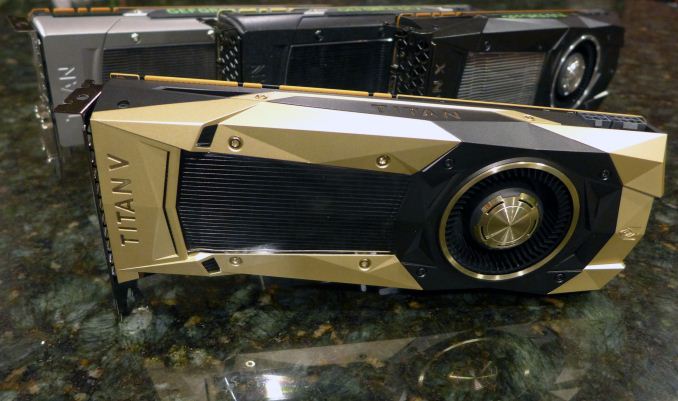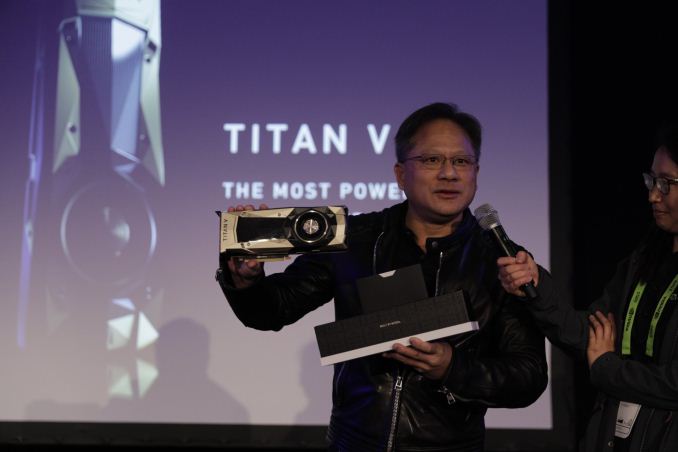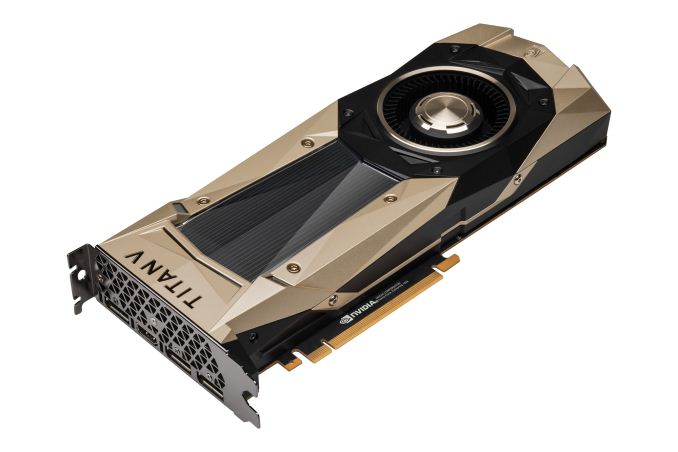The NVIDIA Titan V Preview - Titanomachy: War of the Titans
by Ryan Smith & Nate Oh on December 20, 2017 11:30 AM EST
Over the years we at AnandTech have had the interesting experience of covering NVIDIA’s hard-earned but none the less not quite expected meteoric rise under the banner of GPU computing. Nearly a decade ago CEO Jen-Hsun Huang put the company on a course to invest heavily in GPUs as compute accelerators, and while it seemed likely to pay off – the computing industry has a long history of accelerators – when, where, and how ended up being a lot different than Huang was first expecting. Instead of the traditional high performance computing market, the flashpoint for NVIDIA’s rapid growth has been in neural networking, a field that wasn’t even on the radar 10 years ago.
I bring this up because in terms of NVIDIA’s product line, I don’t think there’s a card that better reflects NVIDIA’s achievements and shifts in compute strategy than the Titan family. Though originally rooted as a sort of flagship card of the GeForce family that lived a dual life between graphics and compute, the original GTX Titan and its descendants have instead transitioned over the years into an increasingly compute-centric product. Long having lost its GeForce branding but not the graphical capabilities, the Titan has instead drifted towards becoming a high performance workstation-class compute card. Each generation of the Titan has pushed farther and farther towards compute, and if we’re charting the evolution of the Titan, then NVIDIA’s latest Titan, the NVIDIA Titan V, may very well be its biggest jump yet.
Launched rather unexpectedly just two weeks ago at the 2017 Neural Information Processing Systems conference, the NVIDIA Titan V may be the most important Titan yet for the company. Not just because it’s the newest, or because it’s the fastest – and oh man, is it fast – or even because of the eye-popping $3000 price tag, but because it’s the first card in a new era for the Titan family. What sets the Titan V apart from all of its predecessors is that it marks the first time that NVIDIA has brought one of their modern, high-end compute-centric GPUs to the Titan family, and what that means for developers and users alike. NVIDIA’s massive GV100 GPU, already at the heart of the server-focused Tesla V100, introduced the company’s Volta architecture, and with it some rather significant changes and additions to NVIDIA’s compute capabilities, particularly the new tensor core. And now those features are making their way down into the workstation-class (and aptly named) Titan V.
| NVIDIA GPU Specification Comparison | ||||||
| Titan V | Titan Xp | GTX Titan X (Maxwell) | GTX Titan | |||
| CUDA Cores | 5120 | 3840 | 3072 | 2688 | ||
| Tensor Cores | 640 | N/A | N/A | N/A | ||
| ROPs | 96 | 96 | 96 | 48 | ||
| Core Clock | 1200MHz | 1485MHz | 1000MHz | 837MHz | ||
| Boost Clock | 1455MHz | 1582MHz | 1075MHz | 876MHz | ||
| Memory Clock | 1.7Gbps HBM2 | 11.4Gbps GDDR5X | 7Gbps GDDR5 | 6Gbps GDDR5 | ||
| Memory Bus Width | 3072-bit | 384-bit | 384-bit | 384-bit | ||
| Memory Bandwidth | 653GB/sec | 547GB/sec | 336GB/sec | 228GB/sec | ||
| VRAM | 12GB | 12GB | 12GB | 6GB | ||
| L2 Cache | 4.5MB | 3MB | 3MB | 1.5MB | ||
| Single Precision | 13.8 TFLOPS | 12.1 TFLOPS | 6.6 TFLOPS | 4.7 TFLOPS | ||
| Double Precision | 6.9 TFLOPS (1/2 rate) |
0.38 TFLOPS (1/32 rate) |
0.2 TFLOPS (1/32 rate) |
1.5 TFLOPS (1/3 rate) |
||
| Half Precision | 27.6 TFLOPS (2x rate) |
0.19 TFLOPs (1/64 rate) |
N/A | N/A | ||
| Tensor Performance (Deep Learning) |
110 TFLOPS | N/A | N/A | N/A | ||
| GPU | GV100 (815mm2) |
GP102 (471mm2) |
GM200 (601mm2) |
GK110 (561mm2) |
||
| Transistor Count | 21.1B | 12B | 8B | 7.1B | ||
| TDP | 250W | 250W | 250W | 250W | ||
| Manufacturing Process | TSMC 12nm FFN | TSMC 16nm FinFET | TSMC 28nm | TSMC 28nm | ||
| Architecture | Volta | Pascal | Maxwell 2 | Kepler | ||
| Launch Date | 12/07/2017 | 04/07/2017 | 08/02/2016 | 02/21/13 | ||
| Price | $2999 | $1299 | $999 | $999 | ||
Our traditional specification sheet somewhat understates the differences between the Volta architecture GV100 and its predecessors. The Volta architecture itself sports a number of differences from Pascal, some of which we’re just now starting to understand. But the takeaway from all of this is that the Titan V is fast. Tap into its new tensor cores, and it gets a whole lot faster; we’ve measured the card doing nearly 100 TFLOPs. The GV100 GPU was designed to be a compute monster – and at an eye-popping 815mm2, it’s an outright monstrous slab of silicon – making it bigger and faster than any NVIDIA GPU before it.
That GV100 is appearing in a Titan card is extremely notable, and it’s critical to understanding NVIDIA’s positioning and ambitions with the Titan V. NVIDIA’s previous high-end GPU, the Pascal-based GP100, never made it to a Titan card. That role was instead filled by the much more straightforward and consumer-focused GP102 GPU, leading to the resulting Titan Xp. Titan Xp itself was no slouch in compute or graphics, however it left a sizable gap in performance and capabilities between it and the Tesla family of server cards. By putting GV100 into a Titan card, NVIDIA has eliminated this gap. However it also changes the market for the card and its expectations.
The Titan family has already been pushing towards compute for the past few years, and by putting the compute-centric GV100 into the card, NVIDIA has essentially ushered that transition to completion. The Titan V now gets all of the compute capabilities of NVIDIA’s best GPU, but in turn it’s more distant than ever from the graphics world. Which is not to say that it can’t do graphics – as we’ll see in detail in a bit – but this is first and foremost a compute card. In particular it is a means for NVIDIA to seed development for the Volta architecture and its new tensor cores, and to give its user base a cheaper workstation-class alternative for smaller-scale compute projects. The Titan family may have started as a card for prosumers, but the latest Titan V is more professional than any card before.
Putting this into context of what it means for existing Titan customers, and it means different things for compute and graphics customers. Compute customers will be delighted at the performance and the Volta architecture’s new features; though they may be less delighted at the much higher price tag.
Gamers on the other hand are in an interesting bind. Make no mistake, the Titan V is NVIDIA’s fastest gaming card to date, but as we’re going to see in our benchmarks, at least right now it’s not radically ahead of cards like the GeForce GTX 1080 and its Titan Xp equivalent. As a result, you can absolutely game on the card and boutique system builders are even selling gaming systems with the cards. But as we’re going to see in our performance results, the performance gains are erratic and there are a number of driver bugs that need squashed. The end result is that the messaging from NVIDIA and its partners is somewhat inconsistent; the $3000 price tag and GV100 GPU scream compute, but then there’s the fact that it does have video outputs, uses the GeForce driver stay, and is NVIDIA’s fastest GPU to date. I expect interesting things once we have proper consumer-focused Volta GPUs from NVIDIA, but that is a proposition or next year.
Getting down to the business end of things, let’s talk about today’s preview. In Greek mythology Titanomachy was the war of the Titans, and for our first look at the Titan V we’re staging our own version of Titanomachy. We’ve rounded up all four of the major Titans, from the OG GTX Titan to the new Titan V, and have tested them on a cross-section of compute, gaming, and professional visualization tasks in order to see what makes the Titan V tick and how the first graphics-enabled Volta card fares. Today’s preview is just that, a preview – we have even more benchmarks cooking in the background, including some cool deep learning stuff that didn’t make the cut for today’s article. But for now we have enough data pulled together to see how NVIDIA’s newest Titan compares to its siblings, and why the Volta architecture just may be every bit as big of a deal as NVIDIA has been making of it.












111 Comments
View All Comments
maroon1 - Wednesday, December 20, 2017 - link
Correct if I'm wrong, Crysis warhead running 4K with 4xSSAA means it is running 8K (4 times as much as 4K) and then downscale to 4KRyan Smith - Wednesday, December 20, 2017 - link
Yes and no. Under the hood it's actually using a rotated grid, so it's a little more complex than just rendering it at a higher resolution.The resource requirements are very close to 8K rendering, but it avoids some of the quality drawbacks of scaling down an actual 8K image.
Frenetic Pony - Wednesday, December 20, 2017 - link
A hell of a lot of "It works great but only if you buy and program exclusively for Nvidia!" stuff here. Reminds me of Sony's penchant for exclusive lock in stuff over a decade ago when they were dominant. Didn't work out for Sony then, and this is worse for customers as they'll need to spend money on both dev and hardware.I'm sure some will be shortsighted enough to do so. But with Google straight up outbuying Nvidia for AI researchers (reportedly up to, or over, 10 million for just a 3 year contract) it's not a long term bet I'd make.
tuxRoller - Thursday, December 21, 2017 - link
I assumed you've not heard of CUDA before?NVIDIA had long been the only game in town when it comes to gpgpu HPC.
They're really a monopoly at this point, and researchers have no interest in making they're jobs harder by moving to a new ecosystem.
mode_13h - Wednesday, December 27, 2017 - link
OpenCL is out there, and AMD has had some products that were more than competitive with Nvidia, in the past. I think Nvidia won HPC dominance by bribing lots of researchers with free/cheap hardware and funding CUDA support in popular software packages. It's only with Pascal that their hardware really surpassed AMD's.tuxRoller - Sunday, December 31, 2017 - link
Ocl exists but cuda has MUCH higher mindshare. It's the de facto hpc framework used and taught in schools.mode_13h - Sunday, December 31, 2017 - link
True that Cuda seems to dominate HPC. I think Nvidia did a good job of cultivating the market for it.The trick for them now is that most deep learning users use frameworks which aren't tied to any Nvidia-specific APIs. I know they're pushing TensorRT, but it's certainly not dominant in the way Cuda dominates HPC.
tuxRoller - Monday, January 1, 2018 - link
The problem is that even the gpu accelerated nn frameworks are still largely built first using cuda. torch, caffe and tensorflow offer varying levels of ocl support (generally between some and none).Why is this still a problem? Well, where are the ocl 2.1+ drivers? Even 2.0 is super patchy (mainly due to nvidia not officially supporting anything beyond 1.2). Add to this their most recent announcements about merging ocp into vulkan and you have yourself an explanation for why cuda continues to dominate.
My hope is that khronos announce vulkan 2.0, with ocl being subsumed, very soon. Doing that means vendors only have to maintain a single driver (with everything consuming spirv) and nvidia would, basically, be forced to offer opencl-next. Bottom-line: if they can bring the ocl functionality into vulkan without massively increasing the driver complexity, I'd expect far more interest from the community.
mode_13h - Friday, January 5, 2018 - link
Your mistake is focusing on OpenCL support as a proxy for AMD support. Their solution was actually developing OpenMI as a substitute for Nvidia's cuDNN. They have forks of all the popular frameworks to support it - hopefully they'll get merged in, once ROCm support exists in the mainline Linux kernel.Of course, until AMD can answer the V100 on at least power-effeciency grounds, they're going to remain an also-ran, in the market for training. I think they're a bit more competitive for inferencing workloads, however.
CiccioB - Thursday, December 21, 2017 - link
What are you suggesting?GPU are a very customized piece of silicon and you have to code for them with optimization for each single architecture if you want to exploit them at the maximum.
If you think that people buy $10.000 cards to be put in $100.000 racks for a multiple $1.000.000 server just to use open source not optimized not supported not guarantee code in order to make AMD fanboys happy, well, not, it's not like the industry works.
Grow up.